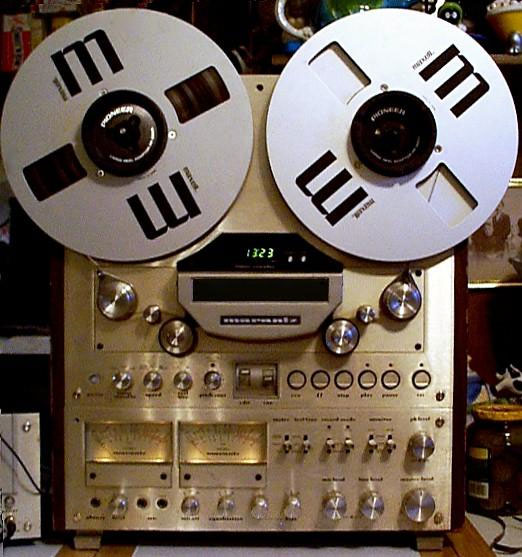Part IV in our look at the history of Recording Studios. Now we move onto Magnetic Recording and Tape, basically what drove the whole rock and roll revolution!
Recording Studios: Magnetic Tape
7″ reel of ¼” recording tape, typical of audiophile, consumer and educational use in the 1950s–60s
Engineers at AEG, working with the chemical giant IG Farben, created the world’s first practical magnetic tape recorder, the ‘K1’, which was first demonstrated in 1935 in recording studios. During World War II, an engineer at the Reichs-Rundfunk-Gesellschaft discovered the AC biasing technique. With this technique, an inaudible high-frequency signal, typically in the range of 50 to 150 kHz, is added to the audio signal before being applied to the recording head. Biasing radically improved the sound quality of magnetic tape recordings. By 1943 AEG had developed stereo tape recorders. Later recording studios adopted that technology.
During the war, the Allies became aware of radio broadcasts that seemed to be transcriptions (much of this due to the work of Richard H. Ranger), but their audio quality was indistinguishable from that of a live broadcast and their duration was far longer than was possible with 78 rpm discs. At the end of the war, the Allies captured a number of German Magnetophon recorders from Radio Luxembourg that aroused great interest. These recorders incorporated all of the key technological features of analogue magnetic recording, particularly the use of high-frequency bias. This was of great interest for use in recording studios.
Development of magnetic tape recorders in the late 1940s and early 1950s is associated with the Brush Development Company and its licensee, Ampex; the equally important development of magnetic tape media itself was led by Minnesota Mining and Manufacturing corporation (now known as 3M). 3M is now a household name and their tapes have been used in many recording studios.
American audio engineer John T. Mullin and entertainer Bing Crosby were key players in the commercial development of magnetic tape. Mullin served in the U.S. Army Signal Corps and was posted to Paris in the final months of World War II; his unit was assigned to find out everything they could about German radio and electronics, including the investigation of claims that the Germans had been experimenting with high-energy directed radio beams as a means of disabling the electrical systems of aircraft. Mullin’s unit soon amassed a collection of hundreds of low-quality magnetic dictating machines, but it was a chance visit to a studio at Bad Neuheim near Frankfurt while investigating radio beam rumours that yielded the real prize.
Mullin was given two suitcase-sized AEG ‘Magnetophon’ high-fidelity recorders and fifty reels of recording tape. He had them shipped home and over the next two years he worked on the machines constantly, modifying them and improving their performance. His major aim was to interest Hollywood studios in using magnetic tape for movie soundtrack recording and in recording studios.
Mullin gave two public demonstrations of his machines, and they caused a sensation among American audio professionals and recording studios—many listeners could not believe that what they were hearing was not a live performance. By luck, Mullin’s second demonstration was held at MGM studios in Hollywood and in the audience that day was Bing Crosby’s technical director, Murdo Mackenzie. He arranged for Mullin to meet Crosby and in June 1947 he gave Crosby a private demonstration of his magnetic tape recorders.
Crosby was stunned by the amazing sound quality and instantly saw the huge commercial potential of the new machines for recording studios. Live music was the standard for American radio at the time and the major radio networks did not permit the use of disc recording in many programs because of their comparatively poor sound quality. But Crosby disliked the regimentation of live broadcasts, preferring the relaxed atmosphere of the recording studio. He had asked NBC to let him pre-record his 1944–45 series on transcription discs, but the network refused, so Crosby had withdrawn from live radio for a year, returning for the 1946–47 season only reluctantly.
Mullin’s tape recorder came along at precisely the right moment. Crosby realized that the new technology would enable him to pre-record his radio show with a sound quality that equaled live broadcasts, and that these tapes could be replayed many times with no appreciable loss of quality. Mullin was asked to tape one show as a test and was immediately hired as Crosby’s chief engineer to pre-record the rest of the series.
Crosby became the first major American music star to use tape to pre-record radio broadcasts, and the first to master commercial recordings on tape. The taped Crosby radio shows were painstakingly edited through tape-splicing to give them a pace and flow that was wholly unprecedented in radio. Mullin even claims to have been the first to use “canned laughter”; at the insistence of Crosby’s head writer, Bill Morrow, he inserted a segment of raucous laughter from an earlier show into a joke in a later show that had not worked well.
Keen to make use of the new recorders as soon as possible, Crosby invested $50,000 of his own money into Ampex, and the tiny six-man concern soon became the world leader in the development of tape recording, revolutionizing radio and recording with its famous Ampex Model 200 tape deck, issued in 1948 and developed directly from Mullin’s modified Magnetophones.





